new posts in all blogs
Viewing: Blog Posts Tagged with: Austin SCBWI, Most Recent at Top [Help]
Results 1 - 25 of 28
How to use this Page
You are viewing the most recent posts tagged with the words: Austin SCBWI in the JacketFlap blog reader. What is a tag? Think of a tag as a keyword or category label. Tags can both help you find posts on JacketFlap.com as well as provide an easy way for you to "remember" and classify posts for later recall. Try adding a tag yourself by clicking "Add a tag" below a post's header. Scroll down through the list of Recent Posts in the left column and click on a post title that sounds interesting. You can view all posts from a specific blog by clicking the Blog name in the right column, or you can click a 'More Posts from this Blog' link in any individual post.
By
Brian Anderson for
Cynthia Leitich Smith's
CynsationsHave you ever wondered why the spacecraft that carried the first U.S. astronaut into space in 1961 was named the Freedom 7? Was
George Lucas already planning six prequels, or what?
When my daughter Amy turned 21 years old in July 2014, she was doing summer research in astrophysics at
Baylor University. Her birthday coincided with a stargazing party at
Meyer Observatory, so I offered to make a piñata and have the star party double as a birthday party.
I started making
custom piñatas when Amy was five years old, and over the years her birthday party piñatas had grown increasingly elaborate.
"How about a black hole piñata," I joked. I imagined one round balloon, decorated all black. She would never agree to that.
"That'd be fantastic!"
I knew right away something was wrong. I told her nothing escapes the gravity of a black hole, not even light. It's just a black dot in space. That's when she told me about accretion disks and X-ray emissions and Hawking radiation. Apparently, I had a lot to learn about black holes, and now I also had a challenging piñata to make.
The following summer my friend and fellow Austin children's book author
Christina Soontornvat told me that
Prufrock Press was looking for an author to write an astronomy dictionary for kids.
Christina and I are both science educators as well as children's book authors, and she thought I'd be perfect for the job. But after the way that black hole piñata joke backfired on me the summer before, I knew I didn't know enough astronomy to write a book about it.
But I knew someone who did.
 |
| Brian & Amy--back in the day. |
Amy had just graduated from college and was taking the summer off before starting graduate school in the fall.
When I suggested we write it together, her first question was the same as mine – isn't there something like this already available online for free?
Her search turned up the same thing mine had: some highly technical glossaries that were clearly not intended for kids, and a scattered collection of incomplete and sometimes incorrect astronomy glossaries for students.
My nine-year-old self was screaming at me that space-loving kids needed this book. Amy felt the same way, and agreed to help write it. We have liftoff!
We compiled a word list of about 450 terms, grouped them into five subject areas, then dived into researching and writing.
The fact that Amy understood the science content much better than I did is part of the reason our collaboration on
Space Dictionary for Kids (Sourcebooks, 2016) worked so well. She brought content mastery and I brought a learner's perspective.
Together we were able to create an astronomy dictionary that's both scientifically accurate and understandable to young readers.
Collaborating with my daughter will always be one of the highlights of my writing career, and Amy taught me a lot of astronomy along the way. I finally understand retrograde motion!
I already knew quasars were the brightest objects in the universe, brighter than an entire galaxy of stars, but until I started working with Amy I never knew exactly what a quasar was. And I also learned (a little too late) that I should have offered to make Amy a black dwarf piñata instead of a black hole piñata.
Cynsational Notes To answer the opening question, each of the Project Mercury astronauts, known collectively as the Mercury 7, was allowed to name the ship that would carry him into space, and each ship's name would end with the number 7. In addition to Freedom 7, the other Mercury spacecraft were Liberty Bell 7, Friendship 7, Aurora 7, Sigma 7, and Faith 7. If you're keeping score, you probably noticed that that was only six. To find out what happened to the seventh Mercury astronaut, flip to page 144.
By
Cynthia Leitich Smithfor
CynsationsDonna Janell Bowman is the first-time author of
Step Right Up: How Doc and Jim Key Taught the World About Kindness, illustrated by
Daniel Minter (Lee & Low, 2016). From the promotional copy:
A Horse that can read, write, and do math?Ridiculous! That’s what people thought until former slave and self-taught veterinarian Dr. William Key, with his “educated” horse Beautiful Jim Key, proved that, with kindness, anything is possible. Over nine years of exhibiting across the country, Doc and “Jim” broke racial barriers, fueled the humane movement, and inspired millions of people to step right up and choose kindness. What was your initial inspiration for writing this book?This question ties so perfectly into my belief that there’s a piece of us in everything we write.
In 2006, I read a
book about Beautiful Jim Key, authored by Mim Eichler Rivas (William Morrow 2005/Harper Paperbacks 2006). It was a given that I would be drawn to a horse book. I grew up on a Quarter Horse ranch, where life revolved around raising, training, and showing horses, and caring for the myriad livestock and other animals. I have always been an animal lover, and I know firsthand how powerful the human-animal bond can be—how the combination of time, trust, and affection can create such synergy that you can practically read each other’s minds.
 |
Courtesy of Tennessee State Library and Archives. |
That kind of relationship bonded William “Doc” Key and his horse, Beautiful Jim Key. While the horse was what drew me to the story, I was immediately awed by Doc. His greatest historical contribution was an unmistakable message about kindness, in a time of extreme racial prejudice, and brutal treatment of animals.
How could I not love the story of a man who overcame so much to make a real difference in the world?
Thanks to Doc, “Jim,” the horse, became a sort of poster child for the emerging humane movement, while Doc overcame injustices, broke racial barriers, and helped change the way people thought about and treated animals. Doc was awarded a Service to Humanity Award, and Jim was awarded a “Living Example” award.
So, back to your question, Cyn, about what inspired me to write this story—it spoke to my heart. I dived into research with zeal.
What were the challenges (literary, research, psychological, logistical) in bringing the text to life?There were a number of challenges to writing this story, but three that most stand out:
First, the research. It was claimed that Beautiful Jim Key could read, write, calculate math problems, compete in spelling bees, identify playing cards, operate a cash register, and more. I had to get to the bottom of how this could be possible.
I used the adult book as my jumping off point, but I wasn’t satisfied to rely solely on somebody else’s research.
This is a story that straddles the 19th and 20th centuries, so I read a great deal about the period, including slavery, the Reconstruction Era in the distinct regions of Tennessee, the history of the humane organizations; the related World’s Fairs, Doc’s business interests, etc.
Emotionally, the most difficult part was reading about how animals were treated in the 19th century, and, more importantly, how enslaved people were often treated with similar brutality. Only a tiny fraction of my research appears in the book’s back matter, but it all deeply affected my approach to the story.
I visited the
Shelbyville (TN) Public Library and skimmed through their microfilm. Then I spent some time at the Tennessee State Archives, donning white gloves as I perused the crumbling scrapbooks from the BJK collection.
During that 2009 trip, I also visited the humble Beautiful Jim Key memorial in Shelbyville, TN, and Doc’s grave site at the Willow Mount Cemetery. (I might have shed a few sentimental tears.) We then tracked down what I think was Doc’s former property, though the house is long gone.
This kind of onsite research, along with old photos and local news accounts, allowed me to imagine the setting of Doc’s hometown. Back home, I collected binders-full of newspaper articles, playbills, and promotional booklets. Through these, I got a feel for how people thought about Doc and Jim.
And, most importantly, I found some of Doc’s explanations for how he taught the horse. What became clear was, though we may never know exactly how the horse was able to do so many remarkable things, the countless news reporters and professors who tried to prove trickery or a hoax, never found anything beyond “education.” Jim only rarely made mistakes.
Ultimately, what Doc and Jim did for the humane movement is even more significant than what the horse performed on stage.
Originally, I had planned the story for middle grade audiences until my agent (who wasn’t my agent yet) suggested that I try a picture book version. I already had half of the chapters written by this time, so I was aghast at the thought of starting over. And I didn’t know how to write a picture book biography. I spent the next two years analyzing and dissecting a couple hundred picture book biographies to figure out how they work.
I decided to
blog about some of my craft observations, using the platform as a quasi-classroom for myself and anyone else who might happen upon my site.
Many, many, many drafts later, I had a manuscript that attracted the attention of a few editors. Lee and Low was the perfect home for Doc and Jim.
There was a built-in challenge in writing this story about a formerly-enslaved African American man. Because I don’t fit any of Doc’s descriptors, it was doubly important that I approach the subject with respect and sensitivity.
I couldn’t merely charge through with the mindset that I’m just the historian sharing documented facts.
How are you approaching the transition from writer to author in terms of your self-image, marketing and promotion, moving forward with your literary art?It is so exciting to finally be crossing the threshold into this new role. The past nine years, which is how long I’ve had the story in my head and in my heart, have felt like the longest-ever pregnancy.
There’s a mixture of joy, relief, and fear during this delivery stage. Fortunately, so far, very nice starred reviews have praised the book, and each reviewer wisely sings the praises of Daniel Minter’s spectacular lino-cut acrylic art.
As I think ahead to marketing and promotion, I’m planning for the Oct. 15 release, the Oct. 23 launch party, and how the book might raise awareness of the need for more kindness in the world—not only toward animals but toward each other.
From my very first draft, nine years ago, I knew I’d revive the original Beautiful Jim Key Pledge—originally signed by two million people during Doc and Jim’s time.
I plan to incorporate the pledge into my author presentations, and it will be downloadable from my website soon. I also hope to align with some humane organizations to help them raise awareness.
I have two more books under contract, several others on submission or in revision, and a novel-in-progress.
In 2018, Peachtree Publishers will release En Garde! Abraham Lincoln’s Dueling Words, illustrated by
S.D. Schindler, followed in 2019 by King of the Tightrope: When the Great Blondin Ruled Niagara, illustrated by
Adam Gustavson.
Such is the author’s life, right? We write, we rewrite, we revise, we sell, we wait, we celebrate, then we do it all over again. Because we can’t imagine not writing something that moves us. And we can’t imagine not writing for young people.
Cynsational GiveawayBook Launch! Join
Donna Janell Bowman at 3 p.m. Oct. 23 at BookPeople in Austin. Donna will be speaking and signing.
Fundraiser: Step Right Up and Help The Rescued Horses of Bluebonnet Equine Human Society: "They are horses, donkeys, and ponies that are helpless and hopeless. And they are hurting. The lucky ones land at Bluebonnet Equine Humane Society. Under the loving care of professional staff and volunteers, the animals are medically and nutritionally rehabilitated, then placed with trainers to prepare them for re-homing/adoption." See also
Interview: Step Right Up Author Donna Janell Bowman by Terry Pierce from Emu's Debuts.
Enter to win two author-signed copies of
Step Right Up: How Doc and Jim Key Taught the World About Kindness by
Donna Janell Bowman, illustrated by
Daniel Minter (Lee & Low, 2016).
a Rafflecopter giveaway
Compiled by
Cynthia Leitich Smithfor
CynsationsCheck out the book trailer for
Teen Frankenstein by
Chandler Baker (Feiwel & Friends, 2016). From the promotional copy:
High school meets classic horror in Teen Frankenstein, Chandler Baker's modern re-imagining of Mary Shelley's gothic novel.
It was a dark and stormy night when Tor Frankenstein accidentally hits someone with her car. And kills him. But, all is not lost―Tor, being the scientific genius she is, brings him back to life...
Thus begins a twisty, turn-y take on a familiar tale, set in the town of Hollow Pines, Texas, where high school is truly horrifying.
 |
| Betty with the 2016 award recipients |
By
Lindsey Lanefor
Cynthia Leitich Smith's
CynsationsBright ideas are wonderful things. They spark imagination, energy, and excitement. That’s good, right?
Executing ideas and fulfilling their promise takes a lot of hard work. The more excitement the better because, along the way, you will learn a lot and some of that knowledge will be hard won.
In 2012, I had a bright idea to create an award in honor of the oldest member of
Austin SCBWI community:
Betty X. Davis who, at the time, was a stalwart ninety-six years old. She joined the first year Austin started an SCBWI chapter twenty years ago. She has cheered and supported all of us at our book launches, read manuscripts for school writing contests and been a thoughtful critique partner.
Really, in terms of support, Betty X. Davis is a pillar of our community. Why not create an award in her honor? I had never done it before but how hard could it be? People do it all the time, right?
By the time you finish reading this post, hopefully, you will be a whole lot smarter about creating honorary awards.
 |
| Maya, grade 3 |
Because I knew Betty would definitely have an opinion about this award, I took her out to lunch. I will admit that I had my own notion about what this award should be. I wanted to offer a scholarship in her honor to, say, a writing retreat or an SCBWI conference or workshop.
“Boring,” she said and dismissed my idea with a wave of her hand. Then she leaned in, “But I will tell you what I would like.”
Uh-oh. I knew right then that whatever came out of Betty’s mouth was going to have to happen. After all, it’s an award to honor her, right? Now I would have to obey her wishes.
What Betty wanted was an annual writing contest for youngsters. You see, what is important to Betty is encouraging young people to write. She believes that a love of writing and reading is essential to a well-lived life. If people wrote more letters to the newspaper, the world would be a better place. If people wrote kind thoughts to one another, the world would be a better place. If people wrote good books with exciting characters, the world would be a better place.
So for Betty, creating a contest that would encourage young people to write and award them for their efforts was absolutely essential.
Frankly, this idea looked like a lot of work: creating a submission system, reading manuscripts, choosing winners. The Austin SCBWI membership is entirely volunteer-based. We are writers and illustrators and many of us have day jobs and families.
Creating a contest looked like a big job that no one, including me, had time to execute. But I knew I wasn’t going to walk away from that lunch without saying yes to her.
While I was feeling a little daunted,
Debbie Gonzales, the Austin SCBWI Regional Advisor at the time, jumped in. “No problem. Let’s find an organization which already has a strong outreach with kids and who can easily corral the submissions.”
Fortunately Austin has two very good organizations which fit that description:
BadgerDog and
Creative Action. Both were willing.
“Partnering with like-minded organizations not only builds community,” says Debbie. “It ignites enthusiasm with the donors and creates a domino-effect of good will.”
With Debbie as my partner in award creation, we turned our attention to funding the award. What would the contest winners receive for their efforts? And who was the contest open to? Even if we gave a blue ribbon and a certificate to the winners, these items cost money.
Austin SCBWI is not a wealthy organization. It couldn’t fund an annual reward. It has to be self-supporting. Fortunately, Betty has a large loving and supportive family and they were willing to seed the award for five years.
“No matter how much trouble it takes to establish an award like Betty’s Young Writers of Merit Award,” says Debbie. “It is worth every turn and twist along the way because young lives are changed when their voices are recognized and celebrated.”
 |
| Gabrielle, grade 11 |
Once we had the seed money commitment, it was time to get busy implementing the award. We joined forces with Creative Action, which has a huge presence in Central Texas schools. Currently they employ eighty teaching artists and serve sixty five schools in three districts. They reach twenty thousand students in forty elementary schools, eleven middle schools and fourteen high schools.
We decided to give an award to one student at each of these school levels: elementary, middle and high school. The three winners would each receive a personalized writing journal and a certificate. The elementary and middle school winners would receive a gift certificate to
BookPeople, Austin’s independent bookstore, and the high school winner would receive $500 upon matriculation to college.
Betty was not keen to attach a monetary prize to the award. The journals, gift certificates were fine. But money? “What did money have to do with the joy of writing?” she wondered.
I convinced her that a monetary award to a high school senior on their way to college, would be really meaningful and give the Betty X. Davis Young Writers of Merit Award a bit of heft and prestige.
“Oh I suppose that’s all right,” she said.
From that initial lunch with Betty to the first presentation of the Betty X. Davis Young Writers of Merit Award at the annual Austin SCBWI conference took seven months. It was fast but bright ideas can have a limited shelf life. They need to be acted on when the enthusiasm is high.
Current Austin SCBWI Regional Advisor
Samantha Clark agrees, “It's a lot of work to put these awards together, and it makes it a lot easier if you're really dedicated because you believe in what you're doing.”
Samantha has been instrumental in getting information about the award up on Austin SCBWI website, creating a donation button making it super easy to contribute and thanking all of the donors.
For the past three years, Betty X. Davis has presented the Young Writers of Merit Award to a diverse group of students from a wide variety of schools, including Austin School for the Blind and Visually Impaired, Garza Independent High School, Westlake High.
This year, at one hundred years young, she will present the elementary award to Maya McNeil, a third grader at Ridgetop Elementary; Keelin Bell a sixth grader at Dailey Middle School and Gabrielle Lewis, a junior at Meridian High School. Once again thanks to the vision of Betty X Davis, young writers will have their voices recognized and celebrated.
Finally, here is quick list of helpful things to remember if you wish to create an award in someone’s honor. Thanks to writer Sarah Azibo for contribution to the list.
Her expertise in this area comes creating many such awards both on her own and through the
Denver Foundation, a philanthropic enterprise, which helps set up legacy gifts as well as provide a not for profit tax umbrella.
The Austin counterpart is the
Live Oak Foundation. Many cities have these foundations.
 |
| Keelin, grade 6 |
- Secure seed money for the award. It takes a while to build momentum until people remember to give on their own. If you are creating a mentorship award, secure commitments for a few years of mentoring.
- Take time to develop a strategy for the fund.
- Create a tracking system to manage donations.
- Designate one person (a bit removed if fund is in memory of a dear one) to be the administrator of the fund.
- Determine who, what, when, where funds are given as specifically as possible from the start.
- Envision ways to keep the fund alive and actively growing with continued donations.
- If it’s not managed through an organization, set-up a separate checking account for the fund.
- Title the fund so that people know who and what it supports.
- Thank all donors with a personal touch.
- Never toil in isolation. If your award is meant to benefit a group of people, reach out to other organizations, which can share the labor and the benefits.
Cynsational NotesLindsey Lane on How a Picture Book Author-Playwright-Journalist Became a YA Author from Cynsations. Peek: "Now I look back and I can see that it all made sense. That each page in each genre taught me a bit more. I can see it because in my YA novel--all of those teachers showed up."
Photographs by
Sam Bond Photography; used with permission.

By:
Cynthia Leitich Smith,
on 2/16/2016
Blog:
cynsations
(
Login to Add to MyJacketFlap)
JacketFlap tags:
fantasy,
Texas author,
Austin SCBWI,
giveaway,
Jill Santopolo,
Debbie Gonzales,
new_voice_2015,
Paige Britt,
Marietta B. Zacker,
Add a tag
By
Cynthia Leitich Smithfor
CynsationsPaige Brittis the first-time author of
The Lost Track of Time, illustrated by Lee White (Scholastic, 2015). From the promotional copy:
A magical fantasy, an allegorical cautionary tale, a feast of language, a celebration of creativity--this dazzling debut novel is poised to become a story for the ages.
Penelope is running out of time.
She dreams of being a writer, but how can she pursue her passion when her mother schedules every minute of her life? And how will she ever prove that writing is worthwhile if her mother keeps telling her to "get busy " and "be more productive"?
Then one day, Penelope discovers a hole in her schedule--an entire day completely unplanned --and she mysteriously falls into it. What follows is a mesmerizing journey through the Realm of Possibility where Penelope sets out to find and free the Great Moodler, the one person who may have the answers she seeks. Along the way, she must face an army of Clockworkers, battle the evil Chronos, take a daring Flight of Fancy, and save herself from the grip of time.
Brimming with clever language and masterful wordplay, The Lost Track of Time is a high-stakes adventure that will take you to a place where nothing is impossible and every minute doesn't count--people do. Was there one writing workshop or conference that led to an "ah-ha!" moment in your craft? What happened, and how did it help you? |
| Jill Santopolo |
I absolutely do have a most memorable workshop! It was actually one you gave in 2008 with
Jill Santopolo, author and editor at Philomel Books. Even though it was over seven years ago, I’ve never forgotten it.
The workshop was organized by the
Austin SCBWI and hosted by
Debbie Gonzales, who was regional advisor at the time.
To register, you had to submit three pages of a work-in-progress. A few weeks before the event, everyone received a packet with copies of all the three-page submissions. Then during the workshop, you and Jill went through each submission and discussed it with the entire group.
You were both kind and encouraging, but also very honest. Jill told us that editors were looking for a reason to say “no” when they read a manuscript. Together you discussed each submission and pointed out the potential “no’s.” Meandering openings, overly long backstory, and hazy plot lines were the most common mistakes.
Even though what you had to say was tough, it was clear you were invested in everyone’s success. You wanted to turn those no’s into yes’s.
Here’s the funny thing. I didn’t even submit my three pages. I registered too late to be a part of the critique, but I went to the workshop anyway. And I’m so glad I did! After the workshop I went home, re-read my three pages, and guess what? They were meandering, “explain-y,” and vague. But because of your input, I could see it. And if I could see it, I could fix it.
 |
| Cynthia Leitich Smith & Debbie Gonzales |
The Lost Track of Time opens with an alarm clock going off, “Beep. Beep. Beep. Beep.” It’s 6 a.m. and even though it’s summer vacation, the main character, Penelope, has to get up and get busy. Right from the start, you know that the central conflict in the story is time.
I did that because of what I learned from you and Jill.
After I fixed my first chapter, I submitted it to two conferences and had sit-down conversations with agents at both. The first agent asked for thirty more pages and the second one,
Marietta B. Zacker, signed me. There is absolutely no way that would have happened if I hadn’t gone to that workshop. I’ve always wanted to tell you and Jill how much you helped me!
As a fantasy writer, going in, did you have a sense of how events/themes in your novel might parallel or speak to events/issues in our real world? Or did this evolve over the course of many drafts?From the beginning, I knew The Lost Track of Time was intimately connected to real-world issues. When I started writing it, I was working for an internet startup. I was constantly on the clock, from morning until night and over the weekends, trying to make the company a success. Everyone was fighting for more time—but no matter what we did, there was never enough. And what time we did have, had to be spent
Constantly! Achieving! Results! Not surprisingly, The Lost Track of Time is about a girl who likes to do nothing. Doing nothing seemed to me like a radical and counter-cultural act. I’m not talking about the nothing where you lie around flipping through TV channels because you’re too exhausted to engage in life.
I’m talking about moodling.
I learned about moodling from
Brenda Ueland in her book,
If You Want to Write. She writes:
“The imagination needs moodling–long, inefficient, happy idling, dawdling and puttering.”
I agree. When you moodle, you’re quiet, still, and (horrors!) unproductive. You let your mind wander until it becomes calm and curious and open. It’s a space of quiet contemplation and intense creativity.
During this busy time in my life, I had no time for quiet contemplation. But when I discovered Brenda Ueland’s words, I suddenly felt I had permission to sit, stare out the window, and moodle. Not only did I have permission, it was imperative that I do so if I wanted to let my own ideas and stories to “develop and gently shine.”
Ueland’s encouragement that everyone moodle touched me so deeply that she inspired a character in my book. She’s the Great Moodler and Penelope fights the tyranny of Chronos and his Clockworkers to save her from banishment in the Realm of Possibility.
As Penelope faces each trial with both imagination and courage, she moves from being an insecure, apologetic daydreamer to a great moodler in her own right.
Research shows a marked decline in U.S. children’s creativity, due to a lack of unstructured free time to play and, I would say, to moodle.
This is terrible news! Not just because creativity is wonderful and life-giving, but because it’s the best predictor we have of a child’s future success, not just in the realms of art and literature, but in the world of business, science, and technology, too.
I’m not sure if you can teach creativity, but I do think you can encourage it. And that’s what I wanted to do in The Lost Track of Time.
I wanted to hold up moodlers as heroes.
Not because they can wield a sword, but because they dare, like Penelope, to enter the Realm of Possibility—to live in the present, to be creative and contemplative, and to believe anything is possible.
 |
| Paige's desk |
Cynsational GiveawayEnter to win one of two signed copies of
The Lost Track of Time by
Paige Britt, illustrated by Lee White (Scholastic, 2015). Author sponsored. Eligible territory: U.S.
a Rafflecopter giveaway

I had the great pleasure of serving on a panel at last month’s Austin SCBWI conference with illustrators Don Tate (shown on the left) and Tom Lichtenheld (the guy in the middle). If those names sound familiar, it’s because I’ve created a book with each of them.
In fact…
Today (no fooling) is the publication date not only of The Amazing Age of John Roy Lynch, which Don illustrated, but also of the board book version of the Tom-illustrated Shark Vs. Train. Both books give readers something to chew on — one figuratively, one literally — so if you know someone with a big appetite for something new to read, won’t you please keep these in mind?

By:
Mark G. Mitchell,
on 9/24/2013
Blog:
How To Be A Children's Book Illustrator
(
Login to Add to MyJacketFlap)
JacketFlap tags:
Society of Children's Book Writers and Illustrators,
Erik Kuntz,
Mark Mitchell,
children's book publishing,
"Make Your Splashes; Make Your Marks",
children's book publishers,
Buz Sawyer,
Dave Roman,
St. Edwards University,
children's book author-illustrators,
children's book illustration course,
First Second Books,
art instruction,
drawing and painting,
Fabulous Furry Freak Brothers,
children's book illustration,
Graphic Novel,
comic,
Candlewick Press,
Cynthia Leitich Smith,
Austin SCBWI,
children's book illustrators,
Add a tag
The upcoming Austin SCBWI Graphic Novel Workshop on Saturday, October 5 promises to be a day for writers and illustrators, writer-illustrators and anyone interested in exciting alternative literary forms for children, teens and young adults. OK, plenty of adults read them, too. Webcomics creator, animator, digital content creator and our SCBWI (Society of Children’s Book […]

By:
Mark G. Mitchell,
on 9/24/2013
Blog:
How To Be A Children's Book Illustrator
(
Login to Add to MyJacketFlap)
JacketFlap tags:
Austin SCBWI,
children's book illustrators,
Society of Children's Book Writers and Illustrators,
Erik Kuntz,
Mark Mitchell,
children's book publishing,
"Make Your Splashes; Make Your Marks",
children's book publishers,
Buz Sawyer,
Dave Roman,
St. Edwards University,
children's book author-illustrators,
children's book illustration course,
First Second Books,
art instruction,
drawing and painting,
Fabulous Furry Freak Brothers,
children's book illustration,
Graphic Novel,
comic,
Candlewick Press,
Cynthia Leitich Smith,
Add a tag
The upcoming Austin SCBWI Graphic Novel Workshop on Saturday, October 5 promises to be a day for writers and illustrators, writer-illustrators and anyone interested in exciting alternative literary forms for children, teens and young adults. OK, plenty of adults read them, too. Webcomics creator, animator, digital content creator and our SCBWI (Society of Children’s Book […]

By:
Mark G. Mitchell,
on 5/25/2013
Blog:
How To Be A Children's Book Illustrator
(
Login to Add to MyJacketFlap)
JacketFlap tags:
art,
animators. children's book artists,
Mira Reisberg,
Erik Kuntz,
Mark Mitchell,
Jeff Crosby,
Bethany Hegedus,
Mary Sullivan,
Lindsey Stirling,
Children's book illustration. Children's book art. Children's book publishing. Children's Book Illus,
Cyntia Leitich Smith,
design,
drawing,
digital painting,
Jake Parker,
Greg Leitich Smith,
Julie Lake,
Amy Farrier,
children's book art,
children's book author-illustrators,
art instruction,
Shelley Ann Jackson,
Will Terry,
The Writing Barn,
painting,
Austin SCBWI,
Add a tag
So what is musician-performer-dancer-composer Lindsey Stirling doing on this blog about children’s book illustration? She’s an artist but she works in a different medium. She hasn’t published a children’s picture book. (Not yet, anyway, but give her time.) I’m sharing this video of her 2011 tune Shadows, because twenty-two million YouTube viewers are not wrong […]

By:
Mark G. Mitchell,
on 2/16/2013
Blog:
How To Be A Children's Book Illustrator
(
Login to Add to MyJacketFlap)
JacketFlap tags:
Caitlin Alexander,
children's book artists,
SCBWI Crystal Kite Award,
Terry Widener,
Willie Mays biography,
children's book illustration,
Children's Books,
Austin SCBWI,
children's book illustrators,
Schwartz and Wade,
Rubin Pfeffer,
Patrice Barton,
Children's publishing,
Amy Farrier,
children's book art,
Shutta Crum,
E.B. Lewis,
Erin McGuire,
Neal Porter,
Laura Logan,
St. Edwards University,
children's book illustration course,
"Mine!",
drawing and painting,
Add a tag
How perfect that award-winning children’s book artist Terry Widener has done the pictures for the new picture book by Jonah Winter (just released by Schwartz and Wade) about the greatest all around baseball player ever – Willie Mays. Terry brings a background of high level advertising and editorial illustration and something else to the many [...]
The WordPress.com stats helper monkeys prepared a 2012 annual report for this blog. Here’s an excerpt: 19,000 people fit into the new Barclays Center to see Jay-Z perform. This blog was viewed about 130,000 times in 2012. If it were a concert at the Barclays Center, it would take about 7 sold-out performances for that [...]

By:
Mark G. Mitchell,
on 8/18/2012
Blog:
How To Be A Children's Book Illustrator
(
Login to Add to MyJacketFlap)
JacketFlap tags:
children's book author-illustrators,
"Make Your Splashes - Make Your Marks!" online course,
Digital Symposium,
artistrators,
children's book illustration,
Austin SCBWI,
Society of Children's Book Writers and Illustrators,
Erik Kuntz,
Mark Mitchell,
children's book art,
children's book publishing,
children's book publishers,
Austin Texas,
Add a tag
Children’s book illustrators, artistrators, writers take note: These guys kind of say it all. The trailer is by animator, web designer, online comics creator Erik Kuntz (who also happens to be our SCBWI chapter’s webmaster.) Briefly, the Second Annual Austin SCBWI Digital Symposium is October 6 at St. Edward’s University in Austin, Texas. But for the [...]

By:
Mark G. Mitchell,
on 6/14/2012
Blog:
How To Be A Children's Book Illustrator
(
Login to Add to MyJacketFlap)
JacketFlap tags:
drawing and painting,
Bill Traylor,
Mark Mitchell. "Marks and Slashes" Lessons,
Seven Impossible thigns Before Breakfast,
The High Museum,
children's book illustration,
Don Tate,
Austin SCBWI,
BookPeople,
Lee and Low Books,
R. Gregory Christie,
children's book art,
New Voices Award,
children's book author-illustrators,
Add a tag
Children’s book illustrator Don Tate never thought of himself as a writer, despite his many children’s author, publishing and librarian friends — a small army’s worth — and being surrounded by journalists all day in his work as a graphics reporter for the Austin American Statesman. He’s illustrated more than 40 educational books and 11 children’s [...]
Yesterday, I had the pleasure of speaking at the
Austin SCBWI monthly meeting at
BookPeople. The title of my talk was "The Impossible and the Improbable and Willing Suspension of Disbelief in Science Fiction and Fantasy." The talk generally covered, among other things, the fact that reality is not realistic, and the discussion ranged from survival cannibalism to the
Titanic to time travel in
CHRONAL ENGINE. A version of the speech will appear in this fall's
Hunger Mountain. If you're not already reading it, you should :-).

After a brief interlude, we celebrated the launch of
IT JES' HAPPENED: WHEN BILL TRAYLOR STARTED TO DRAW (Lee and Low, 2012) with author
Don Tate. He provided the background of the book and how he and illustrator R. Gregory Christie interpreted the events in the life of the folk artist.
All in all, a fun way to spend a Saturday! Thanks, everyone for coming, and happy reading!

By:
Mark G. Mitchell,
on 4/26/2012
Blog:
How To Be A Children's Book Illustrator
(
Login to Add to MyJacketFlap)
JacketFlap tags:
SCBWI,
Uncategorized,
Austin SCBWI,
Multiple sclerosis,
Pictures worth a thousand words,
Dan Yaccarino,
Autoimmune disease,
Houston SCBWI conferences,
JC virus,
Natalizumab,
PML,
Progressive multifocal leukoencephalopathy,
Tysabri,
Add a tag
I’ll go off the topic of children’s book art — just for today. You might have noticed that the blog has been left with the lights still on, but untended in recent months. Not a lot of discussion about illustration, drawing or painting has been going on here. I want to explain, rationalize and ask your [...]

By:
Mark G. Mitchell,
on 8/29/2011
Blog:
How To Be A Children's Book Illustrator
(
Login to Add to MyJacketFlap)
JacketFlap tags:
Children's book illustration,
SCBWI,
Candlewick Press,
Brian Selznick,
Austin SCBWI,
Pictures worth a thousand words,
Knopf Books for Young Readers,
feature interview,
Shutta Crum,
children's book illustrator. Patrice Barton,
Add a tag
Children’s book illustrator Patrice Barton begins a picture book with a spiral ruled notebook that she soon fills with ideas, tactics and to-do checklists related to the project.

It’s almost as if the words come first. The drawings, which for her are a series of tireless explorations only a tiny fraction of which make it to the book, spring forth after she’s worked out the notions, notations and marching orders for herself.
In the previous post she told how she assembled her scraps of sketches on tracing paper to develop finals for Sweet Moon Baby by Karen Henry Clark (Knopf Books for Young Readers.) This time she reveals the earliest stages of her artwork for the picture book Mine! by well-known children’s author Shutta Crum.
Released in June, Mine! is Patty’s second book for Knopf.

At the end of our video interview minutes before class time at the Art School of the Austin Museum of Art Patty walked through the F&G’s for her third Knopf title, Rosie Sprout’s Time to Shine by Knopf editor Allison Wortche — due for publication in December. Here are sophisticated first graders, not babies or toddlers. With their glances, gestures and placements on the pages, Patty orchestrates a very funny elementary school drama of evil plans, remorse and redemption.

Watching her interpret Wortche’s scenes as text gives us insight into how she thinks about her characters and re-constructs a story in its most telling images.

SCBWI happenings for your calendar
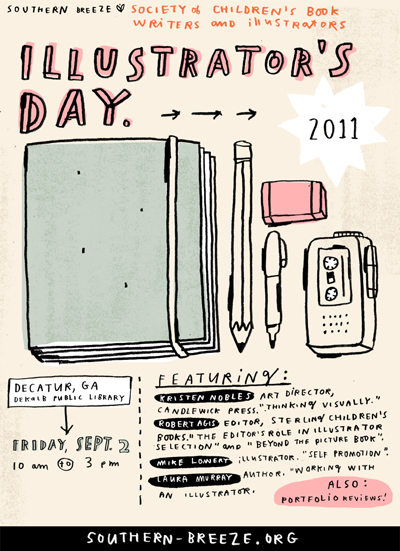
Southern Breeze Society of Children’s BookWriters and Illustrators Illustrators Day – Friday, September 2 on the lower floor of the DeKalb County Public Library,
1 Comments on “Little toddler feet and hands all over my wall…”, last added: 8/29/2011
More than 200 children’s book writers and illustrators (aspiring and professional) converged on a little Unitarian church just north of Austin for the 2010 Destination Publication SCBWI conference January 30.
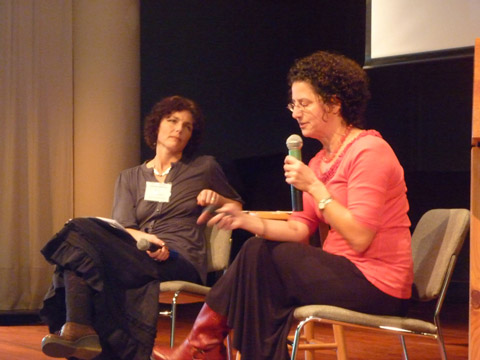
Poet Liz Garton Scanlon and Illustrator Marla Frazee talk about their many months of collaboration with each other and Beach Lane Books V.P. and publisher Allyn Johnston.
Guests and speakers arrived from Texas and everywhere for a day of inspiring presentations and professional critiques of manuscripts and portfolios.
“The most expensive people, all of those those who were trained by the great editors Ursula Nordstrom and Margaret McElderry are gone,” agent and former editor Mark McVeigh said in his rivetting keynote, “Defending Your Muse.”
Still children’s publishing is “not an industry in ruins, but in transition,” he continued. He spoke about the emerging digital media and mobile media (Kindle, iPhone, etc.) marketplace. But he kept returning to the sovereignty of language, individual creativity — and the Emily Dickinson poem he keeps in his wallet. You can read Mark’s recapping of his time with us in Austin and see the full text of the Dickinsin poem on his agency blog here.
Later in the day, Curtis Brown agent Nathan Bransford elicited a gasp or two with his comment that he sees 15,000 to 20,000 submissions a year and might take four to five clients per year from that pile. Yet his presentation, like Mark’s, hit inspiring notes. He refers to the Austin conference and much more in his blog
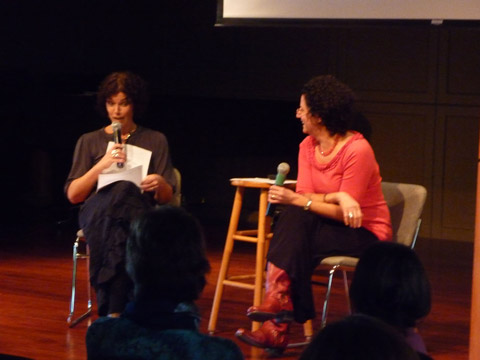
Liz reads one of Marla's e-mails
“Designing the ‘page-turns’ is the most important thing,” asserted two-time Caldecott Honor illustrator Marla Frazee in an extraordinary presentation on the the picture book creation process.
“Use the page turn in the narrative when you want the mood to shift and your images to really stand out,” she continued.
“Save diagonals for the most dramatic parts of your story. They’re like exclamation marks!”
Marla demonstrated how she filled the imagery for All the World (2010 Caldecott Honor book penned by Austin poet Liz Garton Scanlon) with imagery from her own life — landscapes of the central California coast,










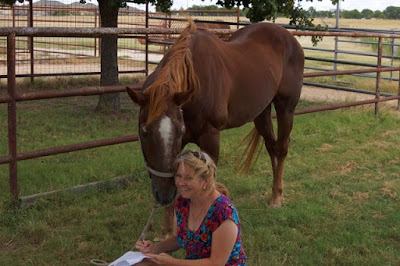






















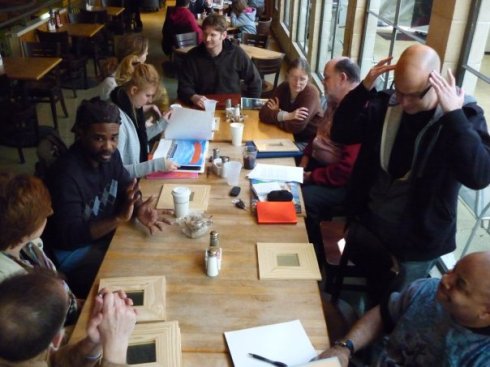
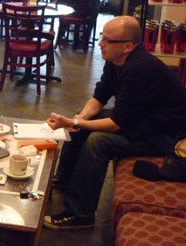


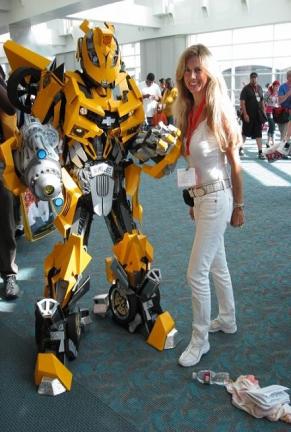






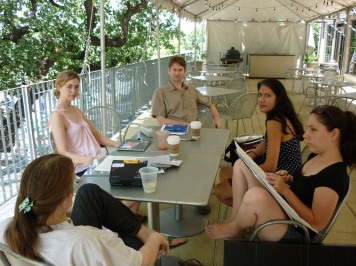
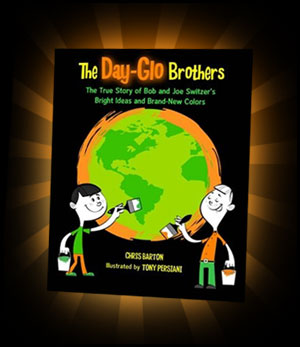
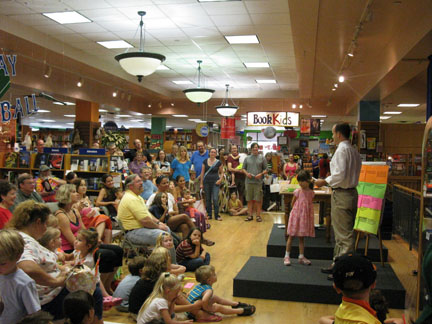

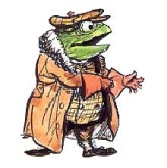



 Marsha Riti grew up in Texas where everything is big, including dreams. So I assumed that she had always dreamed of becoming a children’s book illustrator. Truth is, Marsha knew she had a place in the arts, but it took her a while to discover where that place was.
Marsha Riti grew up in Texas where everything is big, including dreams. So I assumed that she had always dreamed of becoming a children’s book illustrator. Truth is, Marsha knew she had a place in the arts, but it took her a while to discover where that place was.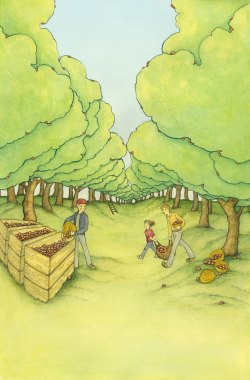 Marsha, how did you evolve from doodler to doer? What got you started in children’s book illustration?
Marsha, how did you evolve from doodler to doer? What got you started in children’s book illustration?
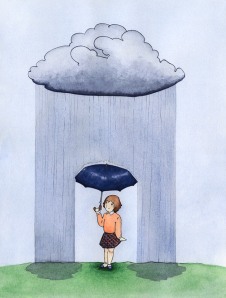
 Each apartment has a very specific owner: the top is a fashionable twenty-something who loves the mid-century look. The next apartment houses the main character, the little girl. Her father (behind the paper) has been everywhere and has the trappings to show it. Then there is the pink apartment—she has lived a long life and loves to listen to her vintage record collection. The bottom apartment is a stay-at-home programmer who is also a bike enthusiast.
Each apartment has a very specific owner: the top is a fashionable twenty-something who loves the mid-century look. The next apartment houses the main character, the little girl. Her father (behind the paper) has been everywhere and has the trappings to show it. Then there is the pink apartment—she has lived a long life and loves to listen to her vintage record collection. The bottom apartment is a stay-at-home programmer who is also a bike enthusiast.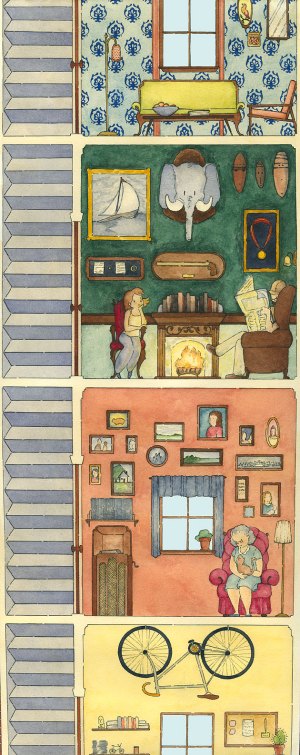 How would you describe your illustration style?
How would you describe your illustration style?
Maybe instead of ‘ball’, I’ll do the same with the word ‘nut’… Also like the illustrations in Grandfather Gandhi – bold, but subtle in layered ways. Nice.
Mark, this is a wonderful post!! Thank you for the inspiration. AND how generous of you to share the other illustration courses. I have to add a plug for YOUR course which you humbly mentioned last. Mark’s course, Make Your Splashes; Make Your Marks!, was career and confidence changing for me! I feel so much more equipped to enter into the world of picture book publishing. Mark teaches a little history, as well as the craft itself and watercolor instruction that empowered me like never before. Reasonably priced and paced to your pocket book and schedule DO NOT MISS THIS excellent class. Mark is always encouraging and gives personal input and feedback. You will grow as an illustrator!